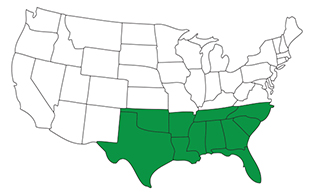
Two-Lined Spittlebug
Prosapia bicinata
The Two-Lined Spittlebug is a jumping, flying, lawn-destroying insect known for attacking Centipedegrass, Bermudagrass, St. Augustinegrass, Bahiagrass and various Ryegrasses. Also known as Prosapia bicinata, this lawn pest can be found in much of the southeastern United States, from parts of Texas to North Carolina.
Identify

Leaf & Stem
An adult Two-Lined Spittlebug has a dark brown to black body that resembles a boat or a wedge. This lawn pest has reddish eyes and legs and sports two prominent reddish-orange bands across its wings, plus a thinner band across the region between its body and head. Two-Lined Spittlebug nymphs are pale yellow with a small orange spot on each side of their abdomens, which enlarges after each molting. These nymphs are usually covered by a spittle mass—a white, frothy protective barrier. Adult Two-Lined Spittlebugs don't produce spittle masses but will jump and fly short distances when disturbed. When these lawn-destroying insects feed, initial damage includes affected areas of grass yellowing and then browning. During feeding, a toxin is injected that translocates throughout the plant, causing death. Severe infestations of this lawn pest may cause a sparse or blighted appearance in your yard. Additionally, the frothy spittle masses created by nymphs are aesthetically unpleasant. Two-Lined Spittlebugs are most active at night and on dark, cloudy days. When disturbed, a droplet of liquid appears at the anal opening of this lawn pest. This droplet, along with the dorsal anus, is visible only with a 10X lens.
Life Cycle
This lawn-destroying insect produces eggs from June to October, and the majority of this pest's activity occurs during the winter months. Two overlapping generations may occur during the winter, with peak populations of the Two-Lined Spittlebug found in late December and late February.

Control
There are two methods for controlling Two-Lined Spittlebugs that TruGreen® recommends: 1. Use professionally applied pest control designed to prevent excess lawn pest populations, which can cause damage to your lawn 2. Kill insects, grubs and other lawn pests before they have a chance to damage your lawn Proper mowing and watering techniques can also help foster a healthy lawn that's more tolerant to lawn pest attacks—plus you'll get a lawn you'll want to live on in the process.







